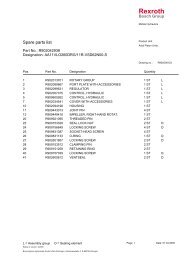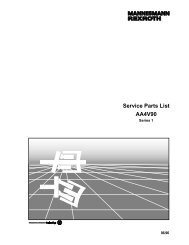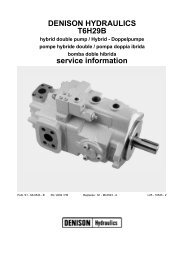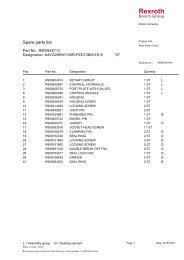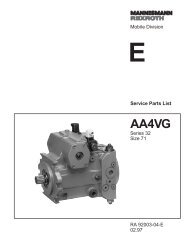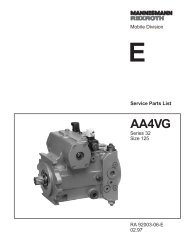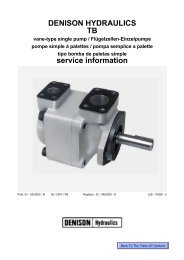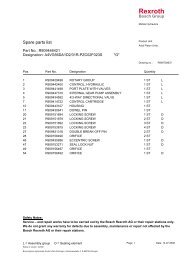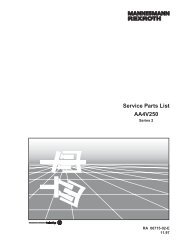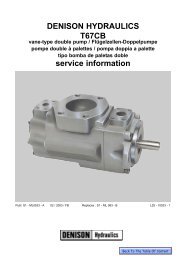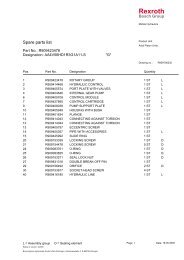S2-AM121 - DDKS Industries, hydraulic components distributor
S2-AM121 - DDKS Industries, hydraulic components distributor
S2-AM121 - DDKS Industries, hydraulic components distributor
You also want an ePaper? Increase the reach of your titles
YUMPU automatically turns print PDFs into web optimized ePapers that Google loves.
Installation Continued Series 24, 30<br />
Alternate Fluids<br />
Some applications require fire-resistant fluids. They will<br />
give good service if the system is originally designed for<br />
their use. Permissible fire resistant fluids include:<br />
Type<br />
Denison Hydraulics Standard<br />
Water-in-oil invert emulsions<br />
HF-3<br />
Water glycol solutions<br />
HF-4<br />
Phosphate esters<br />
HF-5<br />
Consult Denison Hydraulics for design requirements and<br />
warranty limitations for service with this class of fluids.<br />
See Denison Hydraulics bulletin SPO-AM305 for more information.<br />
Maintenance<br />
This motor is self-lubricating and preventative maintenance<br />
is limited to keeping system fluid clean by changing filters<br />
frequently. Keep all fittings and screws tight. Do not operate<br />
at pressures and speeds in excess of the recommended<br />
limit. If the motor does not operate properly, check the<br />
Trouble Shooting Chart before attempting to overhaul the<br />
unit. Overhauling is relatively simple and may be accomplished<br />
by referring to the Disassembly, Rework Limits of<br />
Wear Parts and Assembly Procedures.<br />
Fluid Cleanliness<br />
Fluid must be cleaned before and continuously during operation<br />
by filters that maintain a cleanliness level of NAS 1638<br />
Class 8. This approximately corresponds to ISO 17/14.<br />
This fluid level cleanliness can usually be accomplished by<br />
the effective use of 10 micron filters. Better cleanliness levels<br />
will significantly extend the life of the <strong>components</strong>. As<br />
contaminant generation may vary with each application,<br />
each must be analyzed to determine proper filtration to<br />
maintain the required cleanliness level.<br />
2. Check alignment of drive.<br />
3. Visually inspect <strong>components</strong> and lines for possible<br />
damage.<br />
4. Check reservoir for cleanliness and clean as required.<br />
White glove test on all internal surfaces is recommended.<br />
5. Check fluid level and fill as required with filtered fluid at<br />
least as clean as that recommended. Fill motor case with<br />
clean oil prior to starting.<br />
6. Check oil cooler and activate it, if included in circuit.<br />
Check fluid temperature.<br />
7. Reduce pressure settings of pressure control. Make<br />
sure accurate pressure readings can be made at appropriate<br />
places.<br />
8. If solenoids in system, check for actuation.<br />
9. Start pump drive first by jogging prime mover. Make sure<br />
pump and motor fill properly.<br />
10. Bleed system of air. Recheck fluid level.<br />
11. Cycle unloaded machine at low pressure and observe<br />
actuation (at low speed, if possible).<br />
12. Increase pressure settings gradually in steps. Check<br />
for leaks in all lines especially in pump and motor inlet lines.<br />
13. Make correct pressure adjustments.<br />
14. Gradually increase speed. Be alert for trouble as indicated<br />
by changes in sounds, system shocks and air in fluid.<br />
Inspect oil surface with a good light while in operation. There<br />
must be no surface broken with oil surges and limit surface<br />
air bubbles to occasional.<br />
15. Equipment is operational.<br />
Start Up Procedure for New Installation<br />
1. Read and understand the instruction manual. Identify<br />
<strong>components</strong> and their functions.<br />
TABLE II<br />
COMPARISON OF SOLID CONTAMINATION CLASSIFICATION SYSTEMS<br />
NATIONAL AEROSPACE STANDARD (NAS) 1638<br />
4



